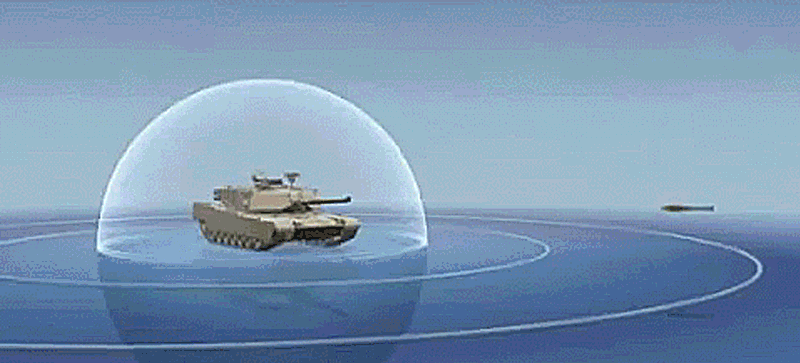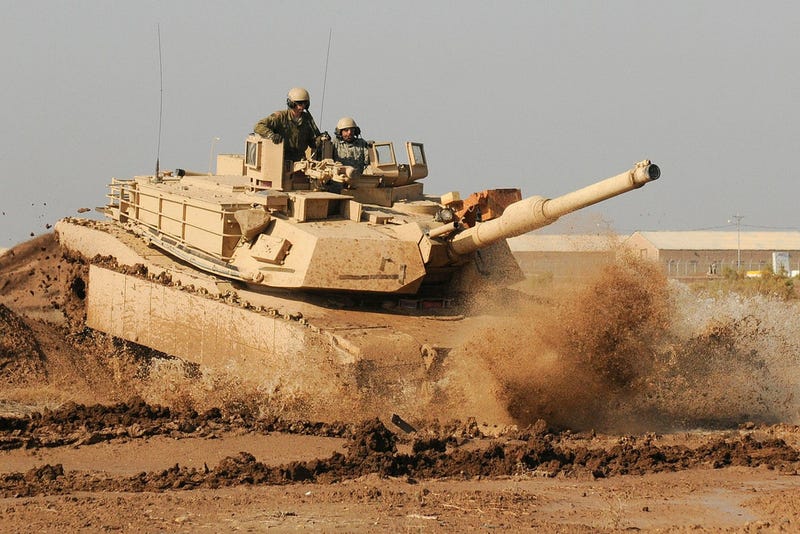
The Trophy Active Protection System.
Years ago, Israeli defense outfit Rafael developed
the equivalent of a “bubble shield” for military vehicles. The Trophy
Active Protection System basically blasts incoming missiles into
oblivion with a turreted shotgun.
Now this tech is finally running on
American M1 Abrams tanks and Stryker armored vehicles.
That’s a problem. But if a tank could stop the RPG from getting close before it made a contact, it could go a long way towards increasing its own survivability. That’s how systems like Trophy work:
Trophy is completely automated and capable of responding to an incoming projectile much faster than a human could, even at close range.
And it does seem to actually work. Back in 2014, video emerged of an RPG being fired at an Israeli Merkava Mk IV tank during one of the country’s many conflicts with Gaza, and the Trophy system was seen easily swatting the RPG out of the sky:
Lt. Gen. Robert Walsh, deputy commandant for combat development and integration, explained in a USNI report that testing is finally about to begin on American armor, after years of deployment in other countries:
To that end, the Marine Corps is partnering with the Army to test out the Israeli Trophy Active Protection System (APS). The Army is leasing four systems and will experiment with their Stryker combat vehicle and M1A2 tanks. The Marine Corps is currently modifying some of its M1A1 tanks to install mounts for the Trophy system, and the service will later work with the Army to test the protective system on the Marine tanks against anti-tank guided missiles and RPGs, he told USNI News after the hearing.The United States Navy already uses technology on its warships using similar ideas, Walsh explained, but the issue with land vehicles is even more complicated.
Weapon systems like tanks and Stryker armored personnel carriers are – strangely enough I know – stuck to land. And because of that, they’re limited in how big they can be and how heavy they can be. As Walsh touched upon in the USNI report, you can’t just keep slapping more and more armor onto them. Either they become too unwieldy to use in battlefield environments, bogged down with overtaxed engines and infrastructure, or they become more and more expensive, with no guarantee that the armor will be able to stop current-generation projectiles, let alone next-generation ones.
That’s where countermeasure systems like Trophy come in to play. In a perfect world, a vehicle equipped with such a system wouldn’t need any hard armor. The incoming artillery shells, missiles, and rocket-propelled grenades would never even touch the vehicle.

As it stands, the Army will reportedly test four such systems in Stryker vehicles and M1A2 tanks while the Marines will modify some of their own M1A1 tanks to mount the Trophy system.
The Stryker is a 19-ton eight-wheeled fighting machine that comes in personnel-carrying, reconnaissance, command, firefighting, medical evacuation, and various weapon-centric configurations. Military.com says the U.S. Army operates more than 2,000 of them.

The M1A1 has been a U.S. military mainstay for decades, with a 120mm main gun that can hit something more than two miles away. This tank has had various tweaks and improvements since its introduction around 1980, including the M1A2 which is basically a technological upgrade, as Fprado.com explains.
Both variants are still operated by the American military.
The “invisible armor” provided by Active Protection Systems could be a huge boost to the strength of these fighting vehicles on the ground, at least when it comes to fighting forces with relatively primitive weapon systems.
That’s because there are already advanced projectiles, like the Russian RPG-30 with counter-countermeasures designed to defeat active protection systems like Trophy. But don’t worry, the company that developed Trophy is already developing a counter-counter-countermeasure system, because such is the nature of war.
It’s called “Trench Coat,” and it’s supposed to shoot 17 different projectiles in every direction, according to Israeli defense publications. One of those should hit something.

Post a Comment Blogger Facebook Disqus